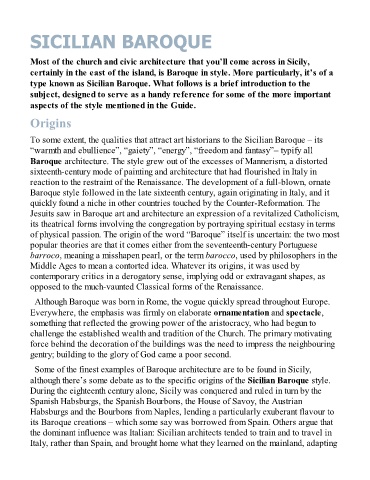Page 583 - The Rough Guide of Sicily
P. 583
SICILIAN BAROQUE
Most of the church and civic architecture that you’ll come across in Sicily,
certainly in the east of the island, is Baroque in style. More particularly, it’s of a
type known as Sicilian Baroque. What follows is a brief introduction to the
subject, designed to serve as a handy reference for some of the more important
aspects of the style mentioned in the Guide.
Origins
To some extent, the qualities that attract art historians to the Sicilian Baroque – its
“warmth and ebullience”, “gaiety”, “energy”, “freedom and fantasy”– typify all
Baroque architecture. The style grew out of the excesses of Mannerism, a distorted
sixteenth-century mode of painting and architecture that had flourished in Italy in
reaction to the restraint of the Renaissance. The development of a full-blown, ornate
Baroque style followed in the late sixteenth century, again originating in Italy, and it
quickly found a niche in other countries touched by the Counter-Reformation. The
Jesuits saw in Baroque art and architecture an expression of a revitalized Catholicism,
its theatrical forms involving the congregation by portraying spiritual ecstasy in terms
of physical passion. The origin of the word “Baroque” itself is uncertain: the two most
popular theories are that it comes either from the seventeenth-century Portuguese
barroco, meaning a misshapen pearl, or the term barocco, used by philosophers in the
Middle Ages to mean a contorted idea. Whatever its origins, it was used by
contemporary critics in a derogatory sense, implying odd or extravagant shapes, as
opposed to the much-vaunted Classical forms of the Renaissance.
Although Baroque was born in Rome, the vogue quickly spread throughout Europe.
Everywhere, the emphasis was firmly on elaborate ornamentation and spectacle,
something that reflected the growing power of the aristocracy, who had begun to
challenge the established wealth and tradition of the Church. The primary motivating
force behind the decoration of the buildings was the need to impress the neighbouring
gentry; building to the glory of God came a poor second.
Some of the finest examples of Baroque architecture are to be found in Sicily,
although there’s some debate as to the specific origins of the Sicilian Baroque style.
During the eighteenth century alone, Sicily was conquered and ruled in turn by the
Spanish Habsburgs, the Spanish Bourbons, the House of Savoy, the Austrian
Habsburgs and the Bourbons from Naples, lending a particularly exuberant flavour to
its Baroque creations – which some say was borrowed from Spain. Others argue that
the dominant influence was Italian: Sicilian architects tended to train and to travel in
Italy, rather than Spain, and brought home what they learned on the mainland, adapting

